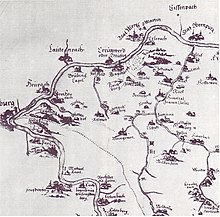Eichelsbach (Elsenfeld)
|
Eichelsbach
Elsenfeld market
Coordinates: 49 ° 50 ′ 53 ″ N , 9 ° 14 ′ 15 ″ E
|
|
|---|---|
| Height : | 329 m above sea level NN |
| Residents : | 850 |
| Incorporation : | July 1, 1971 |
| Postal code : | 63820 |
| Area code : | 09374 |

Eichelsbach is a district of the Elsenfeld market in the Miltenberg district in Bavaria .
geography
The Kirchdorf Eichelsbach lies at 329 m above sea level. NN at Kreisstraße 26 (MIL 26) on a ridge between Hofstetten and Sommerau . Eichelsbach is directly connected to the Main Valley via a local road to Elsenfeld. The Franconian Marienweg leads through the Eichelsbacher corridor, with its field chapel, in which the Mother of God of Fatima ( Fátima in Portugal ) is venerated .
Surname
The name Eichelsbach is derived from the Eichelsbach stream of the same name , which flows into the Neuer Graben in Hofstetten.
history
Archaeological finds show that the region was already settled in the Neolithic period . The area around Eschau , Sommerau and Eichelsbach was settled more than 5000 years ago, as evidenced by ceramic (Bronze Age) grave finds northwest of Sommerau near Eichelsbach and in the Eschau district towards Mönchberg . From pre-Franconian times there was probably no continuous settlement. For the period around 1600–700 BC A relatively dense settlement can be documented by barrows near Eichelsbach.
The Spessart has an eventful history. At first it was an imperial forest and mainly served hunting. As a result, the Archbishops of Mainz were the sovereigns for many centuries . Only from the 12th and 13th centuries did they tolerate the settlement of the Spessart. The Spessart was always ruled from outside. It was ruled by the Archdiocese of Mainz (→ History of the Diocese of Mainz ), the Bishopric Würzburg and some smaller lordships, such as the Counts of Rieneck
In ancient times the village belonged to the Counts of Rieneck. In 1234, Count Ludwig II of Rieneck gave it, along with other properties, to the nearby Himmelthal Monastery . After the Jesuit order was abolished in 1773, the village of Eichelsbach became part of the ore monastery of Mainz.
Of great importance for the early history of Eichelsbach is the so-called Mainzer Koppelfutterverzeichnis (around / after 1250), a tax list for grazing rights granted by the rulers, which reflects the settlement conditions in the area in the middle of the 13th century. Eichelsbach is called "Egilsbach" there.
In 1862 the district office of Obernburg was formed, on whose administrative area Eichelsbach was located. As everywhere in the German Reich , the term district was introduced in 1939. Eichelsbach was now one of the 35 communities in the district of Obernburg am Main (license plate OBB ). On July 1, 1971, the previously independent municipality of Eichelsbach was incorporated into Elsenfeld. With the dissolution of the district of Obernburg, Eichelsbach came to the newly formed district of Miltenberg in 1972 (license plate number MIL ).
Culture
In Eichelsbach there is the sports club FC Eichelsbach , which was founded on June 1, 1955, the music club Widerhall Eichelsbach and a volunteer fire brigade. The Eichelsbach Fruit and Horticultural Association was founded on January 16, 1939 to build a fruit storage cellar for the Eichelsbach residents.
Architectural monuments
| location | object | description | File no. | image |
|---|---|---|---|---|
| Elsenfelder Straße 1 ( location ) |
Catholic branch church St. Barbara | Hall church with retracted three-sided choir and half-hip roof, eight-sided slated gable rider with bell roof, plastered masonry with ashlar structures, baroque, 1750/51; with equipment. 1931 extended by 7 m to the east. | D-6-76-121-19 | |
| Höhenstraße 7 ( location ) |
enclosure | with walled-up spoilage | D-6-76-121-21 | |
| Höhenstraße 7 ( location ) |
Garden wall | with roof-shaped wall crown, exposed sandstone, 18th century, picture niche, sandstone, 19th century with attached saint figure 'St. Anna ', sandstone, 18th century | D-6-76-121-21 | |
| Höhenstraße 7 ( location ) |
Relief attachment | walled up, with a reclining figure, sandstone, 18th century | D-6-76-121-21 | |
| Höhenstraße 14 ( location ) |
Wayside shrine | Inscription base with pillar and relief top 'Marienkrönung' under drapery with cherub, sandstone, marked 1810, top end of the 18th century | D-6-76-121-20 | |
| Upper height ( location ) |
pedestal | with pillar and cross barrel roof relief attachment 'Kreuzschlepper / Pietà / Kreuzigungsgruppe', sandstone, 18th century | D-6-76-121-37 | |
| Sommerauer Weg ( location ) |
Wayside shrine | Column with cross barrel roof niche and relief 'Pietà' and cross crown, sandstone, inscribed 1616 | D-6-76-121-36 | |
| Ziegeläcker ( location ) |
Hall chapel | Small rectangular building with an open vestibule on wooden supports under a gable roof, unplastered sandstone cuboid structure with arched stone frames, marked 1905 | D-6-76-121-35 |
The list does not include the 'Hochkreuz im Kinzbachgrund', forest department "Dicker Schlag", from 1881 (restored in 2017).
Web links
- Spessartagen - The Schafhofbauer
- Spessartagen - The Hochkreuz between Sommerau and Roßbach
- Spessartagen - The Kinzbachfraache
- Eichelsbach in the location database of the Bayerische Landesbibliothek Online . Bavarian State Library
Individual evidence
- ↑ Contour lines on the BayernAtlas of the Bavarian State Government ( notes ).
- ^ Wolf-Armin von Reitzenstein : Lexicon of Franconian place names. Origin and meaning . Upper Franconia, Middle Franconia, Lower Franconia. CH Beck, Munich 2009, ISBN 978-3-406-59131-0 , p. 62 ( limited preview in Google Book search).
- ^ David Hein: OGV Eichelsbach - history. In: Official website of the OGV. Retrieved January 2, 2019 .
